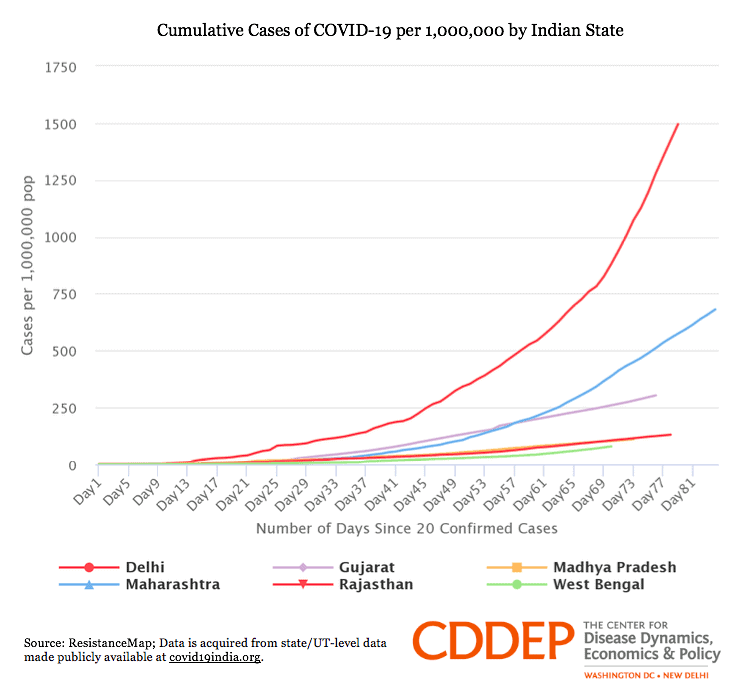June 15, 2020

Flu vaccine coverage linked to reduced antibiotic prescribing in the US. Researchers at CDDEP, Johns Hopkins University, and the University of Maryland School of Medicine conducted a state-level ecological study between 2010 and 2017 and found that flu vaccination coverage was associated with reduced antibiotic prescribing in the United States. The study found that a ten percent increase in influenza vaccination coverage was associated with a 6.5 percent reduction in antibiotic use, or 14.2 fewer antibiotic prescriptions per 1,000 individuals. Across all ages, flu vaccine coverage was significantly and negatively associated with prescribing rates for macrolides, tetracyclines, narrow-spectrum penicillins, and aminoglycosides- all of which are antibiotic classes commonly prescribed for upper respiratory tract infections or severe infections that flu vaccines prevent. [Open Forum Infectious Diseases, CDDEP]
COVID-19
Most African nations lack critical care capacity to respond to COVID-19. In a modeling analysis, researchers at CDDEP found that most African countries do not have sufficient critical care capacity to adequately respond to predicted surges in demand due to COVID-19. Researchers compared the current critical care capacities across African countries to estimated needs at COVID-19 outbreak peak and found that 31 of 50 African countries (62 percent) do not have a sufficient number of hospital beds per 100,000 people (assuming all patients with severe COVID-19 infections seek out health services and all hospital beds are empty and available for use by patients with COVID-19). Only four countries (Cabo Verde, Egypt, Gabon, and South Africa) have a sufficient number of ventilators to meet projected national needs assuming all ventilators are functioning and available for COVID-19 patients. Even if only 30 percent of severely infected patients seek health services at outbreak peak, then 34 of 48 countries (71%) do not have a sufficient number of ICU beds per 100,000 people to handle projected need. [MedRxiv, CDDEP]
Study finds low seroprevalence of novel coronavirus in China. In a study of 17,368 individuals across China between March and April 2020, researchers reported that the seroprevalence of SARS-CoV-2, the virus that causes COVID-19, ranged from 3.2 to 3.8 percent in Wuhan, the original epicenter of the COVID-19 pandemic. Seropositivity decreased as distance from Wuhan increased, and was higher among patients who visited a hospital for maintenance hemodialysis (3.3 percent) as well as healthcare workers (1.8 percent) compared to other populations. [Nature Medicine]
Hydroxychloroquine ineffective as post-exposure prophylaxis for COVID-19. In a randomized controlled trial including 821 individuals across the United States, researchers found hydroxychloroquine ineffective at preventing COVID-19 in adults following high-to-moderate risk exposure to someone with the virus. The incidence of COVID-19 did not differ significantly among individuals randomized to receive hydroxychloroquine compared to placebo four days after exposure (11.8 vs. 14.3 percent, respectively; p=0.35). [NEJM]
False-negative SARS-CoV-2 test results identified in 3.5% of patients. In a study of nearly 21,000 patients across the University of Washington and Stanford health systems, 3.5 percent of patients received a false negative SARS-CoV-2 test result. These patients originally tested negative for SARS-CoV-2 by nasopharyngeal swab, but ended up testing positive on clinical grounds within one week. Results suggest that false-negative nasopharyngeal tests for COVID-19 may occur at a lower rate than previously thought. [Clinical Infectious Diseases]
Clinicians detail rare COVID-19-related inflammatory disorder in children. Clinicians reported a total of 108 confirmed, probable, and possible cases of pediatric inflammatory multisystem syndrome (PIMS) among children in France with COVID-19. Between March and mid-May, pediatric departments around the country reported 156 cases of PIMS, and of these, only 48 were not related to COVID-19. Myocarditis, macrophage activation syndrome, and seritis occurred at higher frequencies among COVID-19-related PIMS cases, while Kawasaki-like disease occurred more frequently among non-COVID-19-related PIMS cases. Approximately two-thirds of COVID-19-related cases required critical care, and one child died. Newly diagnosed PIMS cases rose sharply after April 13th, 4-5 weeks following the peak of France’s COVID-19 epidemic, suggesting that the syndrome is a post-infectious manifestation of the novel coronavirus. [Eurosurveillance]
US emergency department visits declined 42% amid COVID-19 pandemic. The US National Syndromic Surveillance Program (NSSP) reported that emergency department visits declined 42 percent amid the beginning of the COVID-19 pandemic, compared to the same period last year. Visits dropped from an average of 2.1 million per week between March 31 and April 27, 2019, to 1.2 million between March 29 and April 25, 2020, with the greatest reduction in visits among patients 14 years old and younger (71-72 percent). The proportion of infectious disease-related emergency department visits was nearly four times higher this year compared to the same four-week period in 2019 (prevalence ratio: 3.79). Authors suggest that improved messaging is needed to encourage individuals with urgent conditions to seek care, while urging others to engage in virtual visits during the pandemic. [CDC MMWR]
Delhi and Maharashtra report highest rates of COVID-19 in India. [CDDEP]

Drug Resistance and Global Health
Inappropriate antibiotic prescribing decreased slightly in the US. A US study reported a slight decrease in the proportion of inappropriate antibiotics prescribed by physician offices and emergency departments between 2010 and 2015, with the largest decline reported among children, from 32 percent in 2010-11 to 19 percent in 2014-15. The study found that the rate of overall antibiotic prescriptions and prescriptions for acute respiratory infections declined 8 percent and 26 percent, respectively throughout the study period. Researchers note that reduction in unnecessary antibiotic prescribing among children (41 percent) was on track to meet the 50 percent National Action Plan goal by 2020, but more efforts are needed to reduce unnecessary antibiotic prescribing among adults. [Clinical Infectious Diseases]
China’s colistin ban reduces antibiotic resistance in animals and humans. In a comparative study, researchers found that China’s 2017 ban on the use of last-resort antibiotic colistin as an animal growth promoter led to significant reductions in resistance among animals and humans. The median relative abundance of the plasmid-mediated colistin resistance gene, mcr-1, reduced significantly between 2017 and 2018, following implementation of the ban (p=0.0001). The prevalence of colistin-resistant Escherichia coli among samples from pigs and chickens decreased from 34 and 18.1 percent in 2015-16 to 5.1 and 5.0 percent in 2017-18, respectively. The prevalence of mcr-1-positive E coli samples from hospital patients followed a similar trend, decreasing from 14.3 percent in 2016 to 6.3 percent in 2019. [The Lancet Infectious Diseases]
Shorter antibiotic courses may be effective among patients with gram-negative bacteremia. In a randomized controlled trial, researchers in Geneva, Switzerland found that shorter courses of antibiotics are non-inferior to lengthier therapies among patients hospitalized with gram-negative bacteremia. The study found that the 30-day clinical failure rate was significantly lower among patients randomized to receive antibiotics for an individualized duration guided by C-reactive protein (CRP) (2.4 percent) compared to a fixed 14 days (5.5 percent) (p<0.001). A fixed 7-day antibiotic course was also non-inferior to the 14-day course by a 10 percent margin. The researchers defined clinical failure as recurrent bacteremia, complications, restarting antibiotic therapy due to a decline in health, or death. [JAMA]











